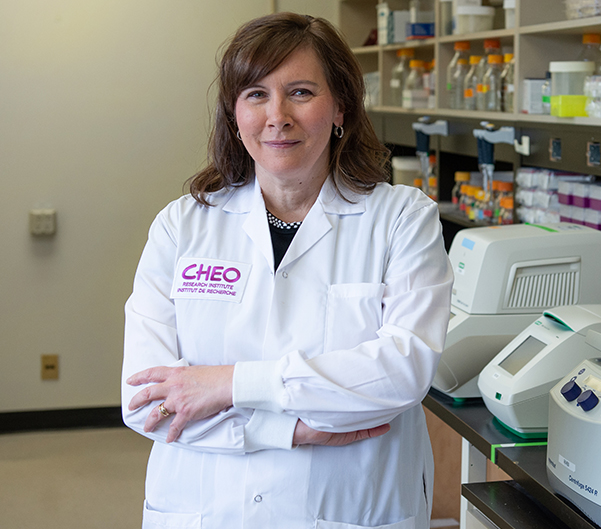Rare disease research finds answers for families

Dr. Kym Boycott discovered her first disease gene while doing her PhD research at the University of Calgary in the mid-1990s.
Using a technique called positional cloning, Dr. Boycott found the gene responsible for X-linked congenital stationary night blindness, a retinal disorder that causes impaired vision and one of the 7,000 known rare genetic diseases that affect more than 3 million Canadians and their families.
Today, Dr. Boycott is a clinician-scientist at CHEO, a pediatric healthcare and research centre in Ottawa, where she has established herself—and Canada—as a world leader in rare diseases. She has discovered rare disease genes, unravelled the biological mechanisms underlying many dieases, and established national and international platforms to share data and facilitate collaboration, while providing the best possible care for her patients and their families.
One major project that Dr. Boycott has led is Care4Rare, a national consortium with 21 sites at universities and hospitals across Canada. Launched in 2011 with funding from CIHR and Genome Canada, Care4Rare involves a remarkably strong collaboration between medical geneticists, genetic counsellors, scientists, bioinformaticians, and, most important, patients and families.
Working with 5,000 families affected by approximately 2,000 different rare diseases, Dr. Boycott and the Care4Rare team have set the pace internationally for rare disease research. The team has so far provided diagnoses or identified compelling candidates for 51% of the participating families and discovered 193 novel disease genes or genetic mechanisms—more than 50 of these discoveries were led by Dr. Boycott’s lab.
“The driving force in my work is to find answers for families,” says Dr. Boycott. “In many cases, families have been searching for years, even decades, for a diagnosis.”
While they started with a mission to improve the diagnosis of rare diseases, the Care4Rare team has also been successful in identifying and testing therapeutic approaches for several rare diseases.
In 2007, for example, Dr. Boycott identified an unknown ataxia (a loss of muscle control) among a group of French-Canadian patients. It took more than 15 years to determine the genetic cause, as the necessary technology, long-read sequencing, was only developed in the last few years. Dr. Boycott is currently planning a clinical trial to determine if 4-aminopyridine, a medication used to treat other neurological disorders, can help manage the symptoms of this condition, which affects eye movements, balance, and coordination.
In another case, in 2015, Dr. Boycott identified the gene responsible for a severe metabolic disorder commonly found among Hutterites, a religious community living in colonies across North America, but now recognized in children worldwide. The disorder causes low manganese in the body, which damages multiple organ systems and impairs neurological development. As a result of this discovery, manganese supplementation is now used as a therapy, and early treatment of children is preventing neurological damage and improving long-term outcomes.
“It’s a very meaningful part of my work to care for patients with rare diseases and to bridge the gap between research and clinical care in an effort to help them,” says Dr. Boycott.
At a glance
Issue
Rare diseases are not so rare. There are more than 7,000 known rare genetic diseases affecting more than 3 million Canadians and their families
Research
CHEO’s Dr. Kym Boycott is leading Care4Rare, a national consortium focused on improving the diagnosis of rare diseases in Canada. Since 2011, the Care4Rare team has pioneered the use of genomic technologies and other tools to diagnose rare diseases, discover novel disease genes—and provide families with answers.
- Date modified: